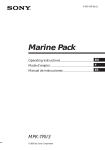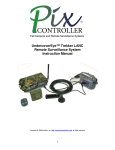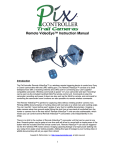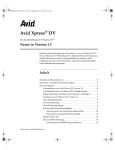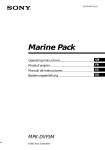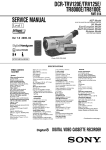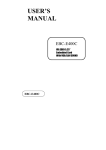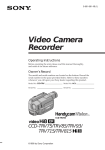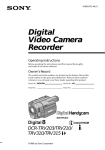Download Sony SPK-TRC User's Manual
Transcript
3-862-537-24(1) Models to be used with the mounting shoe A Modèles à utiliser avec le support de montage A Mounting shoe C Support de montage C Usable at a depth as low as 2 meters (6.5feet) under water. To replace the rubber sheet (Models to be used with the mounting shoe A-3 only) 3 Pour remplacer la feuille de caoutchouc (Modèles devant être utilisés avec le support de montage A-3 seulement). 4 1 Notice 2 2 L 5 Models to be used with the mounting shoe B Modèles à utiliser avec le support de montage B K OC TA ND BY Precautions 1 Mounting shoe C Support de montage C 7 2 3 To disassemble after using Démontage après utilisation Mounting shoe B Support de montage B 4 1 8 Models to be used with the mounting shoe D Modèles à utiliser avec le support de montage D SPK-TRC G Mounting shoe C Support de montage C 1 START/STOP STBY 2 Sony Corporation © 2002 Printed in Japan Zooming Réglage de la longueur focale Mounting shoe D Support de montage D A mounting shoe Support de montage A B Wide-angle Grand-angle arrow number Numéro de flèche model Modèle C W T Telephoto Téléphoto H 1 CCD- TRV31/TRV41/TRV51/TRV81/TRV91/TRV31E/TRV41E/TRV51E/TRV61E/ TRV81E/TRV91E 2 CCD- TR710/TR910/TR2300/TR3300/TR3400/TR610E/TR710E/TR760E/TR810E/ TR910E/TR2200E/TR2300E/TR3100E/TR3300E/TR3400E 3 CCD- TRV95/TRV99/TRV89E/TRV95E/TRV99E 1 CCD- TRV30/TRV40/TRV30E/TRV40E/TRV60E 2 CCD- TR44/TR54/TR64/TR66/TR74/TR78/TR84/TR86/TR88/TR94/TR96/TR98/ TR99/TR330/TR403/TR420/TR440/TR490/TR506/TR507/TR514/TR590/ TR614/TR714/TR814/TR916/TR330E/TR340E/TR401E/TR402E/TR410E/ TR420E/TR440E/TR490E/TR501E/TR502E/TR503E/TR506E/TR510E/ TR520E/TR590E/TR620E/TR720E/TR740E/TRV10/TRV11/TRV12/TRV21/ TRV22/TRV33/TRV112/TRV212/TRV11E/TRV12E/TRV21E 3 CCD- TR1/TR3/TR8/TR200/TR300/TR500/TR1E/TR3E/TR8E/TR18E/TRV32/ TRV34/TRV44/TRV52/TRV53/TRV312/TRV515/TRV44E 4 CCD- TR555/TR555E POWER 5 CCD- TRV101/TRV101E CAMERA 6 CCD- TRV14E/TRV24E OFF 7 DCR-TR7000/TR7000E/TR7100E/TRV110*/TRV210*/TRV310*/TRV315/TRV410/ TRV510/TRV110E*/TRV210E*/TRV310E*/TR410E/TRV510E 3 2 8 1 D 2 DCR-TRV720*/TRV720E*/ CCD- TRV62/TRV72/TRV82/TRV94/TRV54E/TRV56E/TRV94E For future models. Modèles futurs. * The viewfinder adaptor is not available. * L’adaptateur de viseur n’est pas disponible. START/STOP REC • Do not use the sports pack where the wave is high. • Do not subject the front glass to strong shock, as it may crack. • Do not leave the sports pack under direct sunlight for a long period of time, as extreme temperatures may cause damage to the equipment. • If you cannot avoid leaving the sports pack under direct sunlight, be sure to cover the pack with a towel or other protection. • Avoid opening the sports pack in the sea or at the beach. Preparations such as installing and changing a cassette tape should be made in a place with low humidity and no salty air. • If the sports pack is taken to a cold place after being opened in heat or humidity, moisture condensation may occur, causing the glass to fog up and perhaps damaging the equipment. • The water-proof integrity of the sports pack is maintained by the water-proof gasket and the grooved surface it touches. Be especially careful not to damage or deform those areas. • Do not expose the microphone to strong waves. • Do not throw the sports pack into the water. • Use the pack for no longer than one hour at a time in temperatures over 40°C (104°F). You can use the pack normally at temperatures lower than 35°C (95°F). • When using the sports pack in cold places, keep the unit in a bag, etc., except when recording pictures, this prevents the unit from getting extremely cold. • Using the sports pack when the air temperature is freezing point or below is not recommended. But, in unavoidable situations, wrap the unit in something to insulate it. • On some models of the camcorders, you may feel uncomfortable watching the complete wide picture in the viewfinder when you set up your camcorder in the sports pack. This is because there is a gap between the sports pack and the viewfinder. Before You Begin PLAY To make sure that you do not miss good shooting opportunities, go over the following checklist before attaching your camcorder to the sports pack. START/STOP sBattery pack sCassette tape D 1 2 5 I 4 3 sWater-proof gasket CCD-TR950E/TRV66*/TRV64E/TRV66E*/TRV77E*/TRV913E* DCR-TR8000E*/TRV120*/TRV320*/TRV520*/TRV525/TRV120E*/TRV125E*/ TRV320E*/TRV420E*/TRV520E*/TRV620E/ CCD- TR57/TR67/TR87/TR311*/TR315*/TR317*/TR413/TR414/TR416/TR516/ TR517*/TR716/TR917/TR930/TR940/TR311E*/TR315E*/TR317E*/TR411E*/ TR412E*/TR415E*/TR417E*/TR425E*/TR427E*/TR511E*/TR512E/TR515E*/ TR516E/TR617E*/TR640E*/TR713E*/TR717E*/TR730E/TR820E/TR825E/ TR840E*/TR845E*/TR918E*/TR920E/TR1100E/TR3200E/TRV15*/TRV16*/ TRV17*/TRV25*/TRV35*/TRV36*/TRV37*/TRV46*/TRV47*/TRV57*/ TRV65*/TRV67*/TRV75*/TRV85*/TRV87*/TRV93*/TRV215*/TRV240/ TRV340/TRV615*/TRV715*/TRV740/TRV815*/TRV840/TRV3E*/TRV13E*/ TRV15E*/TRV16E*/TRV23E*/TRV26E*/TRV27E*/TRV35E*/TRV36E*/ TRV37E*/TRV45E*/TRV46E*/TRV47E*/TRV48E*/TRV55E*/TRV57E*/ TRV65E*/TRV67E*/TRV69E*/TRV87E*/TRV238E/TRV239E/TRV240E/ TRV300E/TRV340E/TRV738E/TRV740E • Before you start recording, ensure that the video camera recorder is working correctly and there is no water leakage. • Sony does not accept liability for damage to the camcorder, battery, etc. in the sports pack or for the cost of recording if water leakage occurs as a result of an incorrect operation. S Operating Instructions Mode d’emploi Bedienunganleitung Istruzioni per l’uso 6 2 Mounting shoe A Support de montage A When recording under water use the Sony marine pack. For using your video camera recorder with this pack, refer to the operating instructions of the recorder. The water-proof sports pack SPK-TRC has some resistance to water and moisture, making it possible to use the Sony 8mm video camera recorders in the rain or on the beach. 2 Camera mounting shoe Support de montage Body Guide Caisson Guide Rubber sheet Feuille de caoutchouc Sports Pack 6 E 1 2 3 1 2 Français English F B • Fully charged. • The tape length will cover the planned recording time. • The tape is wound to the point where you want to start recording. • The safety tab on the cassette is in the correct position. (The window is not red.) • No scratches or cracks. No dust, sand or hair around them. • Correctly set in the groove. (See “Notes on the Water-proof gasket” in detail. ) Maintenance and Precautions Water Leakage If water happens to leak in, remove the sports pack from the place exposed to water as soon as possible. If the camcorder gets wet, take it to the nearest Sony service facility immediately. Notes on the Water-proof Gasket B Preparing the camera Checking for the water leakage after replacing the water-proof gasket 3 Install the battery pack. Check for the water leakage before installing the camcorder. Close the sports pack without installing the camcorder, and keep the sports pack submerged under water at a depth of about 15 cm (6 inches) for about 3 minutes and then check the water leakage. 5 Set the POWER switch to CAMERA. After recording After recording at a location subjects to sea breezes, wash the sports pack with fresh water with the buckles fastened thoroughly, then wipe with a soft dry cloth. If water remains on the sports pack, the metal parts may rust. Clean the inside of the pack with a soft dry cloth. Do not wash the inside of the pack. Do not use any type of solvent such as alcohol, benzine or shinner for cleaning, as this might damage the finish. Preventing the surface of the glass from fogging up Grease the surface of the glass with the supplied anti-fogging lens solution. This is effective in preventing from fogging. Apply a few drops of anti-fogging lends solution on the inner glass of the sports pack, then wipe with a soft dry cloth so that the solution spreads on the surface of the glass evenly. When storing the sports pack • Close the pack without fastening the buckles to prevent wear of the water-proof gasket. • Avoid the dust not to touch the water-proof gasket. • Avoid storing the sports pack in a cold, very hot or humid space, or together with naphthalene or camphor, otherwise this might damage the unit. Tapering side up Côté effilé vers le haut Groove Rainure F Installing the Camcorder 1 Turn the viewfinder down until it clicks. 2 Connect the microphone plug to MIC jack. 3 Connect the remote control plug to REMOTE (LANC) control jack. 4 Install the camcorder. 1 Align the camera mounting shoe with the guide on the front body. 2 Insert the camcorder by pushing the rear of the camera mounting shoe until it clicks. Check the knobs on both sides of the camera mounting shoe to ensure that the camera mounting shoe is locked properly. (See illustration F4.) mounting shoe Align the mounting shoe C to the notch of mounting shoe A, B or D Replacing the rubber sheet If you use the camcorder CCD-TRV89/TRV95/ TRV99/TRV95E/TRV99E, replace the rubber sheet stuck on the mounting shoe A with the supplied rubber sheet. 5 Set the STANDBY switch of the camcorder to STANDBY. 6 Close the rear body. Before closing the sports pack body, check there is no sand, dust or cracks on the waterproof gasket or the surface where it touches, and grease them slightly. 1 Secure the rear body. 2 Fasten the buckles until it clicks. 1 Remove the rubber sheet stuck on the knob side. 2 Stick the supplied rubber sheet. C Attaching the camera 7 Adjust the grip strap. mounting shoe Holding the sports pack so that the tips of your fingers can easily touch the POWER switch, START/STOP button and ZOOM button, pull the strap to adjust its length. Use metal parts of shoulder belt as shown in the illustration. D Preparing the Camcorder 8 Attach the shoulder strap. Attach the supplied shoulder strap to the hooks for the shoulder strap. The Sony mark should be on the outside. 1 Remove the shoulder strap, lens cap, filter or conversion lens from the camcorder. 2 Install the viewfinder adaptor. 1 Widen a rubber. 2 Install the viewfinder adaptor on the viewfinder. If the viewfinder adaptor is loose when it is attached, bend the eyecup of the camcorder and attach it again. Note When you use a camcorder with the built-in light, set the switch of the light to OFF before installing the camcorder. Using the Sports Pack G Recording 4 Insert the cassette tape. 1 Turn the POWER switch to CAMERA. 2 Press START/STOP to start recording. 6 When you use a camcorder with the LCD screen, close the LCD panel. 7 Set to AUTO LOCK mode for automatic adjustment. The recording lamp lights in the viewfinder, and recording starts. 3 To stop recording, press START/STOP. Press again to resume recording. To finish recording Press START/STOP to stop recording. Then turn the POWER switch to OFF. 8 Set the START/STOP MODE switch to or 5 SEC, if available. 9 When you use a camcorder with finder power save function, set the switch to OFF. 10 Set the STANDBY switch of the camcorder to LOCK. Note When the viewfinder adaptor is attached to the viewfinder of your camcorder, you get a wide view of what appears in the viewfinder screen. However, when viewed from an angle, the screen may appear distorted. E Preparing the Sports Pack 1 Release the buckles. 1 2 3 4 While pressing up the unlock button, Release the buckles. Open the rear body. When using the camcorder CCD-TRV30/ TRV30E/TRV40/TRV40E/TRV60E, stick the black cushion on the inner wall of the sports pack and when using the camcorder CCD-TR610E/TR710E/ TR760E/TR810E/TR910/TR910E/ TR2200E/TR2300E/TR3300/TR3300E/ TR3400E/TR3100E, use the gray cushion. Zooming • Keep the W side pressed for wide-angle. • Keep the T side pressed for telephoto. Press the button firmly for high-speed zoom. Press it softly for a relatively slow zoom. (Depending on the models of your camcorder, whether the function works or not.) • When the focus is set to the water drop on the front glass, adjust the focus with using the zoom button. Note on recording If you leave the camcorder for 5 minutes or more with cassette inserted in Standby mode, the camcorder goes off automatically. This prevents battery and tape wear. To resume Standby mode, turn the POWER switch to OFF and then turn it to CAMERA again. To start recording, press the START/STOP button. Specifications Water-proof Water-proof gasket, buckles Built-in microphone Stereo Supplied accessories Shoulder strap (1), Camera mounting shoe A(1)/B(1)/C(1)/ D(1), Grease (1), Viewfinder adaptor (1), Anti-fogging lens solution (1), Rubber sheet (1), Cushions (2) and Operating Instructions (1) Design and specifications subject to change without notice. H Checking the Recorded Picture You can check the recorded picture in the viewfinder using the Remote Commander supplied with your camcorder. You cannot hear the sound. 1 Set the POWER switch to PLAYER. 2 Press N PLAY on the remote. Use the Remote Commander for all other functions including STOP, REW and FF. Note Depending on the models of your camcorder, the PLAYER function will not work even if the POWER switch is set to PLAYER. The camcorder may change to camera mode. I Removing the Camcorder 1 Release the buckles, and open the rear body. (See illustration E ) Before opening the sports pack, wipe moisture off the sports pack and yourself. Do not allow water on the camcorder. 2 Set the STANDBY switch of the camcorder to LOCK. 3 Holding the camera mounting shoe by the knobs on both sides of it, press the knobs and extract the camcorder. While extracting the camcorder, stop extracting at the point that the remote control plug is come out from the sports pack to disconnect the REMOTE (LANC) control jack. 4 Disconnect the MIC plug from the MIC jack. 5 Detach the viewfinder adaptor. 6 Detach the camera mounting shoe. Le caisson ne peut être utilisé jusqúà 2 mètres sous l’eau. Pour enregistrer sous l’eau, utilisez le caisson marin Sony. En ce qui concerne le fonctionnement du camescope avec le caisson, consultez le mode d’emploi du camescope. Le caisson sport SPK-TRC a une certaine résistance à l’eau et à l’humidité, ce qui permet d’utiliser les camescopes 8 mm Sony sous la pluie ou à la plage. Remarques • Avant de commencer à enregistrer, vérifiez que le camescope fonctionne correctement. • Sony ne peut pas être tenu responsable pour tout dommage du camescope, de la batterie ou autre pièce dans le caisson, ou tout enregistrement manqué, résultant d’une infiltration d’eau consécutive à une utilisation incorrecte. Précautions • N’utilisez pas le caisson si les vagues sont fortes. • Ne pas exposer la vitre avant à des chocs car elle pourrait se briser. • Ne laissez pas le caisson en plein soleil pendant longtemps car la chaleur pourrait l’endommager. • Si vous ne pouvez pas ranger le caisson à l’abri du soleil, recouvrez-le d’une serviette ou autre matériau protecteur. • Evitez d’ouvrir le caisson au bord de la mer ou à la plage. Effectuez toute opération telle que l’installation ou le remplacement de cassette dans un endroit qui n’est pas exposé à l’humidité ni à l’air marin. • Si le caisson est porté dans un endroit froid ou immergé dans l’eau après avoir été ouvert dans un endroit chaud ou humide, de l’humidité risque de se condenser et d’embuer la vitre et éventuellement d’endommager l’appareil. • L’étanchéité du caisson est garantie par le joint d’étanchéité et les surfaces de contact. Faites particulièrement attention de ne pas endommager ni déformer ces parties. • Ne pas exposer le microphone à des vagues fortes. • Ne pas jeter le caisson dans l’eau. • Evitez d’utiliser le caisson pendant plus d’une heure à la fois à des températures supérieures à 40°C. Vous pouvez utiliser le caisson normalement à des températures inférieures à 35°C. • Si vous utilisez le caisson dans un endroit froid, rangez-le dans un sac ou autre quand vous n’enregistrez pas afin d’éviter qu’il ne refroidisse trop. • Il est déconseillé d’utiliser le caisson quand la température est de zéro degré ou inférieure. Cependant, si vous ne pouvez pas faire autrement, enveloppez l’appareil dans un matériau isolant. • Avec certains modèles de camescope, vous aurez du mal à voir entièrement l’image dans le viseur quand vous utilisez le caisson à cause de l’espace entre le viseur et le caisson. Avant de commencer Pour être sûr de ne pas manquer des prises de vues, vérifiez les points suivants avant d’installer le camescope dans le caisson. sBatterie rechargeable sVidéocassette sJoint d’étanchéité Material Plastic (PC, ABS), glass Mass Approx. 800 g (1 lb 12 oz) (only sports pack) J mounting shoe Depending on the location of the screw hole for attaching the camera mounting shoe of your camcorder, you have a choice of three types of camera mounting shoe. Check list A to identify the appropriate mounting shoe and arrow number. • Check that there are no scratches or cracks on the water-proof gasket. Scratches or cracks on the water-proof gasket may cause water to leak in. If there are any, replace the damaged waterproof gasket with a new one. Do not remove the water-proof gasket from the groove with a metal tool or a tool with a sharp point. • Remove foreign materials such as dust, sand or hair from the water-proof gasket, the groove and from any surface it touches. If the body is closed with such materials present, these areas may be damaged and water may leak in. • Put the water-proof gasket in the grooves evenly, with the tapering side up. Never twist them. (See illustration J ) • After checking that there are no cracks or dust on the water-proof gasket, grease it over slightly with the supplied grease using a finger. It prevents wearing. During greasing, recheck for cracks or dust. Never use cloth or paper for greasing as the fibers may cling. Do not use any type of grease other than that supplied, as it may damage the water-proof gasket. • The useful life of the water-proof gasket depends upon the maintenance and the frequency of use, but we recommend changing it once a year. To replace the water-proof gasket, please consult the nearest Sony dealer. Be sure to check the water leakage after replacing the water-proof gasket. Dimensions Approx. 177 x 173 x 274 mm (w/h/d) (7 x 6 7/8 x 10 7/8 inches) 4 Installing the Camcorder A Selecting the camera Trouble Check Symptom Cause Corrective Actions The sound is not recorded. The microphone plug is not connected. Connect it to the MIC jack on the camcorder. • The buckle is not fastened. • The water-proof gasket is not in correct. • There are scratches or cracks on the water-proof gasket. • Fasten the buckle until it clicks. • Put it in the groove evenly. • The battery pack is run out. • The tape has run out. • The safety tab on the cassette is out. • Charge the battery pack fully. • Rewind the tape or use a new one. • Slide the safety tab or install a new cassette tape. There are drops of water inside of the sports pack. The recording and playing back function does not work. • Replace it with a new one. • Complètement chargée. • La longueur de bande est suffisante pour le temps d’enregistrement prévu. • La bande est rebobinée à l'endroit où l'enregistrement doit commencer. • Le taquet de protection de la cassette est sur la position qui permet l’enregistrement. (La fenêtre n’est pas rouge.) • Pas d’égratignures ni de fissures. Pas de poussière, sable ni cheveux sur le joint. • Le joint est bien inséré dans la rainure. (Voir “Remarques sur le joint d'étanchéité” pour les détails.) Entretien et précautions Infiltration d’eau Si de l’eau s’infiltre dans le caisson, changez immédiatement de place. Si le camescope est mouillé, apportez-le immédiatement à un centre de service après-vente Sony. Remarques sur le joint d’étanchéité • Vérifiez qu’il n’y a pas d’égratignures ni fissures sur le joint d’étanchéité car de l’eau pourrait s’infiltrer. Si le joint est endommagé, remplacez-le par un neuf. N’utilisez pas d’outil en métal ni autre objet pointu pour enlever le joint d’étanchéité de la rainure. • Enlevez toute trace de poussière, sable ou cheveu du joint d’étanchéité, de la rainure et autres surfaces en contact. Sinon, si vous fermez le caisson ainsi, ces surfaces risquent d’être endommagées et de l’eau pourrait s’infiltrer. • Insérez le joint de façon régulière dans la rainure avec le côté effilé vers le haut. Ne jamais tordre le joint (Voir l’illustration J.) • Une fois que vous avez vérifié qu’il n’y a pas de fissures ni poussière sur le joint d’étanchéité, appliquez un peu de graisse fournie avec le doigt. Cette graisse protège le joint de l’usure. Pendant le graissage, vérifiez de nouveau qu’il n’y a pas de fissures ni poussière. Ne jamais utiliser de chiffon ou de papier pour le graissage car des fibres pourraient rester collées. N’utilisez pas un type de graisse autre que celui fourni car cela pourrait endommager le joint d’étanchéité. • La durée de vie du joint d’étanchéité dépend de l’entretien et des conditions d’utilisation, cependant, nous recommandons de le changer une fois par an. En ce qui concerne le remplacement du joint d’étanchéité, consultez un revendeur Sony. Vérification des fuites après le remplacement du joint d’étanchéité Vérifiez s’il n’y a pas de fuite avant de monter le camescope. Refermez le caisson sans y mettre le camescope, laissez-le dans l’eau à une profondeur d’environ 15 cm pendant environ 3 minutes, et vérifiez s’il y a des fuites. Après l’enregistrement Installation du camescope A Sélection du support de montage Il existe trois types de support de montage, en fonction de l’endroit où se trouve l’orifice de la vis pour la fixation du support de montage de camescope. Consultez la liste A pour connaître le support de montage et le numéro de flèche appropriés. Matériau Plastique (PC, ABS), verre Etanchéité Joint d’étanchéité, boucles Microphone intégré Stéréo Dimensions Env. 177 x 173 x 274 mm (l/h/p) Poids Env. 800g (caisson uniquement) Accessoires fournis Bandoulière (1) Support de montage A(1)/B(1)/C(1)/D(1), graisse (1), Adaptateur de viseur (1), Solution antibuée (1), Feuille de caoutchouc (1), Tampons (2) et Mode d’emploi (1) 4 Installez le camescope. 1 Alignez le support de montage sur le guide à l’avant du caisson. 2 Insérez le camescope en poussant l’arrière du support de montage jusqu’au déclic. Vérifiez la position des taquets de chaque côté du support de montage pour contrôler si le support est correctement installé. (Voir l'illustration F4.) 5 Réglez le commutateur STANDBY du camescope sur STANDBY. Si vous voulez utiliser le camescope CCDTRV89/TRV95/TRV99/TRV95E/TRV99E, remplacez la feuille de caoutchouc sur le support de montage A par la feuille de caoutchouc fournie. 6 Fermez l’arrière du caisson. 1 Enlevez la feuille de caoutchouc collée du côté du bouton. 2 Collez la feuille de caoutchouc fournie. Avant de fermer le caisson, vérifiez qu’il n’y a pas de sable, poussière ou fissures sur le joint d’étanchéité ou la surface en contact et graissez-les légèrement. 1 Fermez bien l’arrière du caisson, 2 Poussez les boucles jusqu’au déclic. 7 Réglez la courroie de la poignée. Tenez le caisson de sorte que vos doigts puissent atteindre facilement le commutateur POWER, la touche START/STOP et la touche ZOOM, puis tirez sur la courroie pour ajuster la longueur. C Installation du support de montage Utilisez les parties métalliques de la bandoulière comme indiqué sur l’illustration. 8 Fixez la bandoulière. Fixez la bandoulière fournie sur les crochets prévus à cet effet. La marque Sony doit se trouver à l’extérieur. D Préparation du camescope 1 Enlevez la bandoulière, le capuchon, le filtre ou la lentille de conversion du camescope. 2 Installez l’adaptateur de viseur sur le viseur. 1 Ouvrez le caoutchouc. 2 Montez l’adaptateur de viseur sur le viseur. Si l’adaptateur de viseur bouge quand il est fixé, rabattez l’oeilleton du camescope et insérez à nouveau l’adaptateur. 8 Réglez le sélecteur START/STOP MODE sur ou 5 SEC, si présent. Spécifications 3 Branchez la fiche de télécommande sur la prise REMOTE (LANC). Remplacement de la feuille de caoutchouc Pour éviter que de la buée ne se forme sur la vitre • Rangez le caisson sans fermer les boucles pour éviter d’user le joint d’étanchéité. • Evitez que de la poussière ne se dépose sur le joint d’étanchéité. • Evitez de ranger le caisson dans un endroit froid, très chaud ou très humide ou avec des boules de naphtaline ou de camphre car cela pourrait l'endommager. 2 Branchez la fiche de microphone sur la prise MIC. Alignez le support de montage C sur l’encoche du support de montage A, B ou D. Après un enregistrement au bord de la mer, rincez le caisson à l’eau douce en gardant les boucles verrouillées, puis essuyez-le avec un chiffon doux et sec. Si les parties métalliques sont mouillées, elles risquent de rouiller. Nettoyez l’intérieur du caisson avec un chiffon doux et sec. Ne lavez pas l’intérieur du caisson. N’utilisez aucun type de solvant comme de l’alcool, de la benzine ou du diluant car ils pourraient endommager la finition. Rangement du caisson 1 Tournez le viseur vers le bas jusqu’au déclic. B Préparation du support de montage 3 Installez la batterie rechargeable. Appliquez un peu de solution anti-buée fournie sur la vitre. Cette solution est efficace pour éviter la formation de buée. Appliquez quelques gouttes de solution antibuée sur le verre intérieur du caisson sport, puis essuyez-le avec un chiffon doux et sec de manière à bien répartir la solution sur la surface du verre. F Installation du camescope 4 Insérer une cassette. Remarque Quand vous utilisez un camescope avec torche intégrée, réglez l’interrupteur de la torche sur OFF avant d’installer le camescope. Utilisation du caisson G Enregistrement 1 Mettez l’interrupteur POWER sur CAMERA. 2 Appuyez sur START/STOP pour démarrer l’enregistrement. 5 Réglez l’interrupteur POWER sur CAMERA. L’indicateur d’enregistrement s’allume dans le viseur et l’enregistrement commence. 6 Quand vous utilisez un camescope avec écran LCD, fermez l’écran LCD. 3 Pour arrêter l’enregistrement, appuyez sur START/STOP. 7 Réglez le mode AUTO LOCK pour passer en mode de réglage automatique. Appuyez à nouveau pour reprendre l’enregistrement. Pour cesser d’enregistrer Appuyez sur START/STOP pour arrêter l’enregistrement. Puis, mettez l’interrupteur POWER sur OFF. 9 Quand vous utilisez un camescope avec fonction d’économie d’énergie, réglez le commutateur sur OFF. 10 Réglez le commutateur STANDBY du camescope sur LOCK. Remarque Quand l’adaptateur de viseur est installé sur le viseur du camescope, l’image qui apparaît dans le viseur est grossie, mais vue de côté, elle peut apparaître déformée. E Préparation du caisson 1 Déverrouillez les boucles. 1 Tout en appuyant sur la touche de déverrouillage, 2 Déverrouillez les boucles. 3 Ouvrez la partie arrière. 4 Quand vous utilisez les CCD-TRV30/ TRV30E/TRV40/TRV40E/TRV60E, collez le tampon noir sur la paroi interne du caisson, et quand vous utilisez les CCD-TR610E/ TR710E/TR760E/TR810E/TR910/TR910E/ TR2200E/TR2300E/TR3300/TR3300E/ TR3400E/TR3100E, collez le tampon gris. Réglage de la longueur focale • Tenez enfoncé le côté W pour filmer en grandangle. • Tenez enfoncé le côté T pour filmer en téléphoto. Appuyez fermement sur la touche pour changer plus rapidement la focale. Appuyez légèrement pour changer lentement la focale. (Varie selon le modèle de camescope et s'il est équipé de cette fonction.) • Si la mise au point est effectuée avec la goutte d’eau sur le verre avant, ajustez la mise au piont à l’aide du bouton de zoom. Remarque sur l’enregistrement Si vous laissez le camescope en mode d’attente pendant 5 minutes ou plus avec une cassette insérée, il s’éteint automatiquement afin d’éviter une usure inutile de la batterie et de la bande. Pour revenir en mode d’attente, mettez l’interrupteur POWER sur OFF, puis de nouveau sur CAMERA. Pour commencer l’enregistrement, appuyez sur la touche START/STOP. Guide de dépannage Problème Cause Le son n'est pas enregistré. La fiche de microphone n'est pas Branchez-la sur la prise MIC du camescope. branchée. Présence de gouttes d'eau à l'intérieur du caisson. • Les boucles ne sont pas verrouillées. • Le joint d'étanchéité est mal inséré. • Egratignures ou fissures sur le joint d'étanchéité. • Verrouillez les boucles jusqu'au déclic. • Insérez le joint régulièrement dans la rainure. • Remplacez le joint par un neuf. L'enregistrement et la lecture ne fonctionnent pas. • La batterie est épuisée. • La bande est finie. • Rechargez complètement la batterie. • Rebobinez la bande ou utilisez une autre cassette. • Rentrez le taquet ou utilisez une autre cassette. La conception et les spécifications sont modifiables sans préavis. • Le taquet de la cassette est sonti. Solution H Contrôle de l’image enregistrée Vous pouvez contrôler l’image enregistrée dans le viseur en utilisant la télécommande fournie avec le camescope. Vous ne pouvez pas entendre le son. 1 Mettez l’interrupteur POWER sur PLAYER. 2 Appuyez sur N PLAY de la télécommande. Utilisez la télécommande pour toutes les autres fonctions, y compris l’arrêt, le rembobinage et l’avance rapide. Remarque Selon les modèles de camescope, la touche PLAYER ne fonctionnera pas même si l’interrupteur POWER est réglé sur PLAYER. Le camescope peut se mettre en mode d’enregistrement. I Retrait du camescope 1 Déverrouillez les boucles et ouvrez la partie arrière. (Voir l’illustration E ) Avant d’ouvrir le caisson, essuyez toute trace d’eau sur le caisson et sur vous. Ne laissez pas d’eau entrer en contact avec le camescope. 2 Réglez le commutateur STANDBY du camescope sur LOCK. 3 Tout en tenant le support de montage par les taquets de chaque côté, appuyez sur les taquets et sortez le camescope. Arrêtez-vous au moment où la fiche de télécommande sort du caisson pour la débrancher de la prise REMOTE (LANC). 4 Débranchez la fiche de microphone de la prise MIC. 5 Retirez l’adaptateur de viseur. 6 Enlevez le support de montage. C A Montageschuh Pfeil-Nr. Attacco di Numero montaggio freccia A B START/STOP 2 CCD- TR710/TR910/TR2300/TR3300/TR3400/TR610E/TR710E/TR760E/TR810E/ TR910E/TR2200E/TR2300E/TR3100E/TR3300E/TR3400E 3 CCD- TRV95/TRV99/TRV89E/TRV95E/TRV99E CCD- TRV30/TRV40/TRV30E/TRV40E/TRV60E 2 CCD- TR44/TR54/TR64/TR66/TR74/TR78/TR84/TR86/TR88/TR94/TR96/TR98/ TR99/TR330/TR403/TR420/TR440/TR490/TR506/TR507/TR514/TR590/ TR614/TR714/TR814/TR916/TR330E/TR340E/TR401E/TR402E/TR410E/ TR420E/TR440E/TR490E/TR501E/TR502E/TR503E/TR506E/TR510E/ TR520E/TR590E/TR620E/TR720E/TR740E/TRV10/TRV11/TRV12/TRV21/ TRV22/TRV33/TRV112/TRV212/TRV11E/TRV12E/TRV21E 3 CCD- TR1/TR3/TR8/TR200/TR300/TR500/TR1E/TR3E/TR8E/TR18E/TRV32/ TRV34/TRV44/TRV52/TRV53/TRV312/TRV515/TRV44E 4 CCD- TR555/TR555E 5 CCD- TRV101/TRV101E 6 CCD- TRV14E/TRV24E 7 DCR-TR7000/TR7000E/TR7100E/TRV110*/TRV210*/TRV310*/TRV315/TRV410/ TRV510/TRV110E*/TRV210E*/TRV310E*/TR410E/TRV510E 2 DCR-TR8000E*/TRV120*/TRV320*/TRV520*/TRV525/TRV120E*/TRV125E*/ TRV320E*/TRV420E*/TRV520E*/TRV620E/ CCD- TR57/TR67/TR87/TR311*/TR315*/TR317*/TR413/TR414/TR416/TR516/ TR517*/TR716/TR917/TR930/TR940/TR311E*/TR315E*/TR317E*/TR411E*/ TR412E*/TR415E*/TR417E*/TR425E*/TR427E*/TR511E*/TR512E/TR515E*/ TR516E/TR617E*/TR640E*/TR713E*/TR717E*/TR730E/TR820E/TR825E/ TR840E*/TR845E*/TR918E*/TR920E/TR1100E/TR3200E/TRV15*/TRV16*/ TRV17*/TRV25*/TRV35*/TRV36*/TRV37*/TRV46*/TRV47*/TRV57*/ TRV65*/TRV67*/TRV75*/TRV85*/TRV87*/TRV93*/TRV215*/TRV240/ TRV340/TRV615*/TRV715*/TRV740/TRV815*/TRV840/TRV3E*/TRV13E*/ TRV15E*/TRV16E*/TRV23E*/TRV26E*/TRV27E*/TRV35E*/TRV36E*/ TRV37E*/TRV45E*/TRV46E*/TRV47E*/TRV48E*/TRV55E*/TRV57E*/ TRV65E*/TRV67E*/TRV69E*/TRV87E*/TRV238E/TRV239E/TRV240E/ TRV300E/TRV340E/TRV738E/TRV740E DCR-TRV720*/TRV720E*/ CCD- TRV62/TRV72/TRV82/TRV94/TRV54E/TRV56E/TRV94E 1 5 2 I OFF 6 E 1 3 2 2 J Spitz zulaufende Seite nach oben Lato appuntito verso l’alto Rille Scanalatura B 4 (Nur für Modelle mit Montageschuh A) Per sostituire il tappetino di gomma 2 Montageschuh Attaco di montaggio videocamera Gehäuse Führung Corpo Guida 6 1 2 (Solo modelli da usare con l’attacco di montaggio A-3) 2 5 L Gummiunterlage Tappetino di gomma 2 K OC S TA Montageschuh A Attacco di montaggio A ND BY 7 Bei Modellen, die mit Montageschuh B verwendet werden Modelli da usare con l’attacco di montaggio B 2 1 Zum Auseinanderbauen nach dem Betrieb Per smontare dopo l’uso 4 1 • Verwenden Sie das Sports Pack nicht bei hohem Wellengang. • Stoßen Sie nicht gegen das Glasfenster an der Vorderseite, da es sonst zerbricht. • Legen Sie das Sports Pack nicht längere Zeit in die pralle Sonne, da es sich sonst zu stark erwärmen kann und das Gerät im Inneren beschädigt werden kann. • Wenn kein schattiger Platz gefunden werden kann, schützen Sie das Sports Pack durch ein Handtuch o.ä. vor prallem Sonnenlicht. • Öffnen Sie das Sports Pack nicht im Meer und nicht am Strand. Alle Vorbereitungen, wie Einlegen und Wechseln der Cassette, sollten an einem Ort, der keiner Feuchtigkeit und keiner Salzluft ausgesetzt ist, erfolgen. • Wenn das Sports Pack an einen kalten Ort gebracht wird, nachdem es zuvor an einem warmen oder feuchten Ort geöffnet war, kann sich Feuchtigkeit im Inneren ansammeln. Das Frontglas kann dann beschlagen, und eventuell kann auch das Gerät im Inneren beschädigt werden. • Die Wasserabdichtung des Sports Pack wird durch eine Gummidichtung und den Rand, auf dem die Dichtung aufliegt, gewährleistet. Achten Sie darauf, daß diese Teile nicht beschädigt oder deformiert sind. • Achten Sie darauf, daß das Mikrofon keinen starken Wellen ausgesetzt wird. • Werfen Sie das Sports Pack nicht ins Wasser. • Verwenden Sie das Sports Pack nicht länger als eine Stunde bei Umgebungstemperaturen um oder über 40 °C. Wenn die Temperaturen unter 35 °C liegen, kann das Sports Pack uneingeschränkt verwendet werden. • Bei kalten Umgebungstemperaturen sollte die Einheit in einer Tasche o.ä. aufbewahrt werden, damit sie nicht zu stark abkühlt, und erst vor dem Aufnehmen herausgenommen werden. • Auch bei Umgebungstemperaturen um oder unter dem Gefrierpunkt sollte das Sports Pack möglichst nicht verwendet werden. Falls ein Betrieb bei solchen Temperaturen unumgänglich ist, wickeln Sie die Einheit zur Isolation ein. • Bei einigen Camcordertypen ist der Randbereich des Sucherbildes nicht gut zu sehen, da der Abstand zwischen dem Fenster des Sports Pack und dem Sucherokular relativ groß ist. Überprüfungen vor dem Aufnehmen 3 Montageschuh C Attacco di montaggio C • Bevor Sie mit der Aufnahme beginnen, vergewissern Sie sich, daß der Camcorder einwandfrei arbeitet und kein Wasser eindringt. • Sony übernimmt keine Verantwortung für den im Sports Pack eingesetzten Camcorder, Akku usw. und ersetzt auch keine Aufnahmekosten, wenn aufgrund von falscher Bedienung Wasser in das Gehäuse eingedrungen ist. Zur besonderen Beachtung 4 1 3 Montageschuh C Attacco di montaggio C 4 CAMERA * Der Sucheradapter ist nicht erhältlich. * L’adattatore mirino non è disponibile. Zum Austauschen der Gummiunterlage Hinweise 3 POWER F Für zukünftige Modelle. Per modelli futuri. Bei Modellen, die mit Montageschuh A verwendet werden Modelli da usare con l’attacco di montaggio A Für Unterwasseraufnahmen verwenden Sie das Sony Marine Pack. Lesen Sie auch die Anleitung des Camcorders durch. Das wasserfeste Sports Pack SPK-TRC weist einen gewissen Widerstandsgrad gegen Wasser und Feuchtigkeit und erlaubt es, Sony Video-8Camcorder im Regen oder am Strand einzusetzen. D 1 CCD-TR950E/TRV66*/TRV64E/TRV66E*/TRV77E*/TRV913E* D Vor dem Einsetzen des Camcorders in das Sports Pack gehen Sie die folgende Liste durch, um sicherzustellen, daß alle Funktionen einwandfrei arbeiten. 8 sAkku sVideocassette Montageschuh B Attacco di montaggio B Bei Modellen, die mit Montageschuh D verwendet werden Modelli da usare con l’attacco di montaggio D Montageschuh C Attacco di montaggio C G 1 START/STOP STBY Zoomen Zoomata Weitwinkel Grandangolo Montageschuh D Attacco di montaggio D Italiano Bis zu einer Tiefe von 2 m unter Wasser verwendbar. PLAY Modello CCD- TRV31/TRV41/TRV51/TRV81/TRV91/TRV31E/TRV41E/TRV51E/TRV61E/ TRV81E/TRV91E 1 3 2 Modell 1 8 Deutsch H W T Tele Teleobiettivo 2 START/STOP REC sDichtung • Voll laden. • Die Bandlänge muß für die geplante Aufnahmezeit ausreichen. • Das Band muß sich an der Stelle befinden, an der die Aufnahme beginnen soll. • Der Löschschutz der Cassette darf nicht aktiviert sein (rote Markierung nicht sichtbar). • Die Dichtung darf keine Kratzer oder Risse aufweisen. Auf oder an der Dichtung dürfen kein Staub, kein Sand und keine Haare vorhanden sein. • Die Dichtung muß richtig in der Rille sitzen (siehe „Hinweise zur Dichtung“). Zur besonderen Beachtung Bei einem Wasserleck Wenn Wasser eingedrungen ist, bringen Sie das Sports Pack umgehend an einen Ort, der keinem Wasser ausgesetzt ist. Wenn der Camcorder naß geworden ist, bringen Sie ihn so schnell wie möglich zur nächsten Sony Kundendienststelle. Hinweise zur Dichtung • Überprüfen Sie die Dichtung auf Kratzer und Risse. Kratzer und Risse können den wasserdichten Abschluß beeinträchtigen. Wechseln Sie die Dichtung in einem solchen Fall aus. Zum Herausnehmen der Dichtung aus der Rille verwenden Sie keinen Metallgegenstand und keinen anderen Gegenstand mit scharfen Kanten. • Entfernen Sie Fremdkörper wie Staub, Sand oder Haare von der Dichtung, der Rille und der Gehäuseoberfläche, die die Dichtung berührt. Wenn Fremdkörper vorhanden sind, können die Kontaktflächen beim Schließen des Gehäuses beschädigt werden und es besteht die Gefahr, daß Wasser eindringt. • Setzen Sie die Dichtung mit der spitz zulaufenden Seite nach oben hin weisend ein. Achten Sie darauf, daß die Dichtung gleichförmig in der Rille sitzt und nicht verdreht ist (siehe Abb. J). • Nachdem Sie überprüft haben, daß keine Risse und kein Staub auf der Dichtung vorhanden sind, fetten Sie die Dichtung leicht mit Ihrem Finger mit dem mitgelieferten Fett ein. Das Fett verhindert eine vorzeitige Abnutzung. Überprüfen Sie beim Einfetten noch einmal die Dichtung auf Risse und Staub. Zum Einfetten darf auf keinen Fall ein Tuch oder Papier verwendet werden, da sonst Fasern auf der Dichtung hängenbleiben können. Verwenden Sie stets nur das mitgelieferte Fett; durch andere Fettarten kann die Dichtung beschädigt werden. • Die Lebensdauer der Dichtung hängt von der Pflege und der Häufigkeit der Verwendung ab. Im allgemeinen wird empfohlen, die Dichtung jährlich auszuwechseln. Zum Auswechseln wenden Sie sich an Ihren Sony Händler. Nach einem Auswechseln der Dichtung überprüfen Sie stets das Gehäuse auf wasserdichten Abschluß. Überprüfen des wasserdichten Abschlusses nach dem Auswechseln der Dichtung Schließen Sie das Sports Pack ohne eingesetzten Camcorder, tauchen Sie es 3 Minuten lang ca. 15 cm ins Wasser ein, und überprüfen Sie, ob Wasser eindringt. Nach der Aufnahme Nach dem Einsatz in Meeresluft waschen Sie das Sports Pack bei geschlossenen Schnallen mit Süßwasser sorgfältig ab, und trocknen Sie es dann mit einem weichen Tuch ab. Durch Wasserrückstände auf dem Sports Pack können die Metallteile rosten. Reinigen Sie das Innere des Sports Pack ebenfalls mit einem weichen, trockenen Tuch. Verwenden Sie jedoch kein Wasser. Lösungsmittel wie Alkohol und Benzin dürfen nicht verwendet werden, da sie das Gehäuse angreifen. Um ein Beschlagen des Frontglases zu verhindern Behandeln Sie das Frontglas mit dem mitgelieferten Antibeschlagmittel. Bringen Sie einige Tropfen des Antibeschlagmittels auf das Innenglas des Sports Pack auf und wischen dann mit einem weichen, trockenen Lappen ab, so daß die Lösung gleichmäßig über die Glasoberfläche verteilt wird. Zur Aufbewahrung des Sports Pack • Klappen Sie das Sports Pack zu. Lassen Sie jedoch die Schnallen offen, um die Dichtung zu schonen. • Sorgen Sie dafür, daß die Dichtung nicht verstaubt ist. • Bewahren Sie das Sports Pack nicht an einem sehr kalten, sehr warmen oder feuchten Ort und auch nicht an einem Ort auf, der Naphtalen- oder Camphor-Dämpfen ausgesetzt ist, da es sonst zu Beschädigungen kommen kann. Einsetzen des Camcorders A Auswählen des KameraMontageschuhs Wählen Sie je nach der Position der Schraubenbohrung an Ihrem Camcorder einen geeigneten Montageschuh aus. Drei verschiedene Montageschuhe stehen zur Auswahl. Zum Montageschuh und zur Pfeil-Nr. siehe Liste A. B Vorbereiten des Montageschuhs Richten Sie den Montageschuh C auf die Kerbe am Montageschuh A, B oder D aus. Austauschen der Gummiunterlage Wenn Sie den Camcorder CCD-TRV89/TRV95/ TRV99/TRV95E/TRV99E verwenden, tauschen Sie die Gummiunterlage am Montageschuh A mit der mitgelieferten Gummiunterlage aus. 1 Nehmen Sie die an der Knopfseite angebrachte Gummiunterlage ab. 2 Setzen Sie die mitgelieferte Gummiunterlage an. C Anbringen des Montageschuhs am Camcorder Befestigen Sie den Montageschuh, wie in der Abbildung gezeigt, mit der Metallzunge des Schulterriemens. D Vorbereiten des Camcorders 1 Nehmen Sie den Schulterriemen und die Objektivkappe, das Filter bzw. den Konverter vom Camcorder ab. 2 Bringen Sie den Sucheradapter an. 1 Weiten Sie die Gummimuschel. 2 Bringen Sie den Adapter am Sucher an. Wenn der Sucheradapter nicht richtig fest sitzt, verbiegen Sie die Okularmuschel und bringen Sie den Adapter erneut an. 3 Setzen Sie den Akku ein. Wasserdichter Abschluß Dichtung, Schnallen Eingebautes Mikrofon Stereo Abmessungen ca. 177 x 173 x 274 mm (B/H/T) Gewicht ca. 800 g (nur Sports Pack) Mitgeliefertes Zubehör Schulterriemen (1), Montageschuh A(1)/B(1)/C(1)/D(1), Fett (1), Sucheradapter (1), Antibeschlagmittel (1), Gummiunterlage (1), Kissen (2), Bedienungsanleitung (1) Änderungen, die dem technischen Fortschritt dienen, bleiben vorbehalten. H Prüfen des Aufnahmebildes 1 Klappen Sie den Sucher bis zum Klickpunkt nach unten. Sie können das aufgenommene Bild mit Hilfe der mitgelieferten Fernbedienung im Sucher prüfen. Der Ton ist jedoch nicht zu hören. 2 Stecken Sie den Mikrofonstecker in die MIC-Buchse. 3 Stecken Sie den Stecker des Steuerkabels in die REMOTE l (LANC)Buchse. 4 Schieben Sie den Camcorder in das Gehäuse. 1 Richten Sie den Montageschuh auf die Führung am vorderen Gehäuseteil aus. 2 Schieben Sie den Camcorder hinein, so daß er mit einem Klicken einrastet. Drücken Sie hierzu an der Rückseite des Montageschuhs. Vergewissern Sie sich anhand der Laschen an beiden Seiten des Montageschuhs, daß dieser richtig eingerastet ist (siehe Abb. F4). 5 Stellen Sie den STANDBY-Schalter des Camcorders auf STANDBY. 6 Bringen Sie das hintere Gehäuseteil an. Überprüfen Sie zuvor, daß auf der Dichtung und der Auflagefläche kein Sand, kein Staub und keine Risse vorhanden sind und fetten Sie die Teile leicht ein. 1 Drücken Sie das hintere Gehäuseteil leicht an. 2 Schließen Sie die Schnallen. 7 Bringen Sie das Griffband an. Stellen Sie die Länge des Bandes so ein, daß Sie den POWER-Schalter, die START/STOPTaste und die ZOOM-Taste bequem mit Ihren Fingern bedienen können. 8 Bringen Sie den Schulterriemen an. Stecken Sie den Riemen wie in der Abbildung gezeigt durch die Ösen, und achten Sie darauf, daß das Sony-Zeichen nach außen weist. 5 Stellen Sie den POWER-Schalter auf CAMERA. 6 Wenn Sie einen Camcorder mit LCDisplay verwenden, schließen Sie das LC-Display. 7 Falls ein AUTO LOCK-Schalter vorhanden ist, stellen Sie ihn auf Automatikbetrieb. 8 Falls ein START/STOP MODE-Schalter vorhanden ist, stellen Sie ihn auf oder 5 SEC. 9 Wenn der Camcorder eine Sucherabschaltautomatik besitzt, stellen Sie den Schalter auf OFF. 10 Stellen Sie den STANDBY-Schalter des Camcorders auf LOCK. Hinweis Bei am Sucher angebrachtem Sucheradapter kann das Sucherbild aus einem breiterem Blickwinkel betrachtet werden. Beim Betrachten von der Seite ist das Bild jedoch möglicherweise verzerrt. E Vorbereiten des Sports Pack 1 Lösen Sie die Schnallen. 1 Während Sie die Lösetaste gedrückt halten, ... 2 ... lösen Sie die Schnallen. 3 Nehmen Sie das hintere Gehäuseteil ab. 4 Bei Verwendung des Camcorders CCDTRV30/TRV30E/TRV40/TRV40E/ TRV60E kleben Sie dasschwarze Polster und bei Verwendung des Camcorders CCD-TR610E/TR710E/TR760E/TR810E/ TR910/TR910E/TR2200E/TR2300E/ TR3300/TR3300E/TR3400E/TR3100E kleben Sie das graue Polster an die innere Wand des Sports Pack. 1 Stellen Sie den POWER-Schalter auf PLAYER. 2 Drücken Sie N PLAY an der Fernbedienung. Zur Steuerung des Bandlaufs verwenden Sie die Fernbedienungstasten STOP, REW und FF. Hinweis Je nach verwendetem Camcordermodell arbeitet die PLAYER-Funktion nicht, auch wenn der POWER-Schatler auf PLAYER gestellt ist. Der Camcorder schaltete möglicherweise auf Kameramodus um. I Herausnehmen des Camcorders 1 Lösen Sie die Schnallen, und nehmen Sie das hintere Gehäuseteil ab (siehe Abb. E.) Bevor Sie das Sports Pack öffnen, trocknen Sie das Sport Pack und sich selbst ab. Achten Sie sorgfältig darauf, daß der Camcorder nicht naß wird. 2 Stellen Sie den STANDBY-Schalter am Camcorder auf LOCK. 3 Fassen Sie den Montageschuh an den beiden seitlichen Laschen an, drücken Sie die Laschen dann zusammen, und ziehen Sie den Camcorder soweit heraus, daß das Fernsteuerkabel von der REMOTE (LANC)-Buchse abgetrennt werden kann. Trennen Sie das Kabel dann ab. 4 Trennen Sie das Mikrofonkabel von der MIC-Buchse ab. Hinweis 5 Nehmen Sie den Sucheradapter ab. Wenn Sie einen Camcorder mit eingebauter Leuchte verwenden, stellen Sie den Leuchtenschalter auf OFF, bevor Sie den Camcorder anbringen. 6 Nehmen Sie den Montageschuh ab. 4 Setzen Sie die Cassette ein. Technische Daten Material Plastik (PC, ABS), Glas F Einsetzen des Camcorders Verwendung des Sports Pack G Aufnahme 1 Drehen Sie den POWER-Schalter auf CAMERA. 2 Drücken Sie START/STOP zum Starten der Aufnahme. Die Aufnahmelampe leuchtet im Sucher, und die Aufnahme beginnt. 3 Zum Stoppen der Aufnahme drücken Sie START/STOP. Durch erneutes Drücken kann die Aufnahme wieder fortgesetzt werden. Am Ende der Aufnahme Drücken Sie START/STOP, um die Aufnahme zu stoppen, und drehen Sie dann den POWER-Schalter auf OFF. Zoomen • Durch Drücken der W-Seite wird in den Weitwinkelbereich gefahren. • Durch Drücken der T-Seite wird in den Telebereich gefahren. Durch festes Drücken erfolgt das Zoomen mit hoher und durch leichtes Drücken mit langsamer Geschwindigkeit (abhängig vom Camcorder-Modell ist möglicherweise jedoch nur ein Zoomen mit fester Geschwindigkeit möglich). • Wenn die Kamera auf Wassertropfen auf dem Frontglas scharfgestellt het, betätigen Sie die Zoomtaste, bis das Motiv scharf ist. Hinweis zur Aufnahme Wenn der Camcorder länger als 5 Minuten mit eingelegter Cassette auf Bereitschaft geschaltet bleibt, schaltet er sich automatisch aus (um den Akku nicht unnötig zu belasten und das Band zu schonen). Zum Zurückschalten auf Bereitschaft drehen Sie den POWER-Schalter einmal auf OFF und dann wieder auf CAMERA. Anschließend können Sie die Aufnahme wie gewohnt durch Drücken der START/STOP-Taste unmittelbar starten. Störungsüberprüfungen Symptom Ursache Abhilfe Der Ton wird nicht aufgezeichnet. Der Mikrofonstecker ist nicht angeschlossen. Den Stecker an die MIC-Buchse des Camcorders anschließen. Im Sports Pack befinden sich Wassertropfen. • Die Schnallen sind nicht richtig geschlossen. • Die Dichtung ist nicht richtig eingesetzt. • Die Dichtung ist verkratzt oder gerissen. • Die Schnallen richtig schließen, so daß sie einrasten. • Die Dichtung richtig in die Rille einsetzen. • Die Dichtung auswechseln. Aufnahme- und Wiedergabefunktion arbeiten nicht. • Der Akku ist leer. • Das Band ist am Ende angelangt. • Der Löschschutz der Cassette ist aktiviert. • Den Akku laden. • Das Band zurückspulen oder eine andere Cassette einsetzen. • Den Löschschutz desaktivieren oder eine andere Cassette einsetzen. Utilizzabile sott’acqua ad una profondità di 2 metri massimo. Per registrare sott’acqua, usare la custodia subacquea Sony. Per usare la videocamera registratore con questa custodia, fare riferimento alle istruzioni per l’uso della videocamera. La custodia sportiva impermeabile SPK-TRC è parzialmente resistente all’acqua e all’umidità, rendendo possible l’uso di una videocamera registratore Sony a 8mm sotto la pioggia o su una spoaggia. Avvertenza • Prima di iniziare la registrazione, assicurarsi che la videocamera registratore funzioni correttamente e che non ci siano infiltrazioni d’acqua. • La Sony non si assume alcuna responsabilità per danni alla videocamera, al blocco batteria, ecc. nella custodia sportiva o per il costo della registrazione se si verificano infiltrazioni d’acqua dovute a operazioni scorrette. Precauzioni • Non usare la custodia sportiva dove le onde sono alte. • Non sottoporre il vetro anteriore a forti urti, perché potrebbe rompersi. • Non lasciare la custodia sportiva esposta alla luce solare diretta per un periodo prolungato, perché una temperatura molto alta potrebbe danneggiare la videocamera. • Se non è possibile evitare di lasciare la custodia sportiva al sole, coprirla con un asciugamano o simili. • Evitare di aprire la custodia sportiva in acqua o sulla spiaggia. Operazioni preliminari come l’inserimento e l’estrazione della cassetta devono essere eseguite in luoghi con poca umidità e senza brezze salmastre. • Se si porta la custodia sportiva in un luogo freddo dopo averla aperta in un luogo caldo o molto umido, può verificarsi condensazione di umidità, che fa appannare il vetro e a volte può danneggiare l’apparecchio. • L’impermeabilità della custodia sportiva è mantenuta dalla guarnizione a tenuta d’acqua e dalla superficie scanalata della custodia a contatto con la guarnizione. Fare particolare attenzione a non danneggiare o deformare queste parti. • Non esporre il microfono a onde forti. • Non gettare la custodia sportiva nell’acqua. • Usare la custodia per non più di un’ora alla volta quando la temperatura è di 40°C. È possibile usare normalmente la custodia a temperature inferiori ai 35°C. • Se si usa la custodia sportiva in luoghi freddi, tenerla in una borsa, ecc. tranne quando si registra, per evitare che si raffreddi eccessivamente. • Si sconsiglia di usare la custodia sportiva quando la temperatura dell’aria è al punto di congelamento o inferiore. Tuttavia, quando non si può evitare di usare la custodia in situazioni simili, avvolgere la custodia in qualcosa per isolarla. • Con alcuni modelli di videocamere, si può avvertire un certo disagio nel guardare l’immagine in tutta la sua larghezza nel mirino quando la videocamera è inserita nella custodia sportiva. Questo è dovuto allo spazio fra la custodia sportiva e il mirino. Prima dell’uso Per essere sicuri di non perdere qualche eccezionale occasione di ripresa, eseguire i seguenti controlli prima di inserire la videocamera nella custodia sportiva. sBlocco batteria sVideocassetta sGuarnizione a tenuta d’acqua • Completamente carico. • Durata sufficiente per il tempo di registrazione previsto. • Nastro riavvolto fino al punto in cui si desidera iniziare la registrazione. • Linguetta di protezione della cassetta nella posizione corretta. (Finestrella non rossa.) • Assenza di graffi o incrinature. Assenza di polvere, sabbia o capelli intorno ad essi. • Correttamente inserita nella scanalatura. (Fare riferimento a “Note sulla guarnizione a tenuta d’acqua” per i dettagli.) Manutenzione e precauzioni Caratteristiche tecniche Infiltrazioni d’acqua Materiale Plastica (PC, ABS), vetro Se l’acqua penetra all’interno, portare via la custodia dal luogo esposto all’acqua il più presto possibile. Se la videocamera si bagna, portarla immediatamente al più vicino centro di assistenza Sony. Note sulla guarnizione a tenuta d’acqua • Controllare che non ci siano graffi o incrinature sulla guarnizione a tenuta d’acqua. Graffi o incrinature possono causare infiltrazioni d’acqua. In caso fossero presenti, sostituire la guarnizione danneggiata con un’altra nuova. Non usare oggetti metallici o strumenti appuntiti per estrarre la guarnizione dalla scanalatura. • Eliminare i materiali estranei come polvere, sabbia o capelli dalla guarnizione, dalla scanalatura e dalle superfici della custodia a contatto con la guarnizione. Se si chiude la custodia quando tali materiali sono presenti, queste aree possono essere danneggiate dando luogo a infiltrazioni d’acqua. • Inserire la guarnizione nella scanalatura uniformemente, con il lato appuntito rivolto verso l’alto. Non torcere mai la guarnizione. (Vedere l’illustrazione J.) • Dopo aver controllato che non ci siano incrinature o polvere sulla guarnizione, lubrificare leggermente la guarnizione con il grasso in dotazione con un dito. Il grasso protegge la guarnizione dall’usura. Mentre si lubrifica la guarnizione, controllare di nuovo che non ci siano incrinature o polvere. Non usare mai stoffa o carta per l’operazione perché delle fibre possono rimanere attaccate alla guarnizione. Non usare un grasso diverso da quello in dotazione, perché potrebbe danneggiare la guarnizione. • La durata utile della guarnizione dipende dalla manutenzione e dalla frequenza d’impiego, ma consigliamo di cambiarla una volta all’anno. Per la sostituzione della guarnizione a tenuta d’acqua, rivolgersi ad un rivenditore Sony. Assicurarsi di controllare che non si verifichino infiltrazioni d’acqua dopo aver sostituito la guarnizione a tenuta d’acqua. Controllo di infiltrazioni d’acqua dopo la sostituzione della guarnizione a tenuta d’acqua Controllare che non si verifichino infiltrazioni d’acqua prima di inserire la videocamera nella custodia. Chiudere la custodia sportiva senza inserirvi la videocamera, e tenere la custodia immersa nell’acqua ad una profondità di circa 15 cm per circa 3 minuti, e quindi controllare che non vi siano infiltrazioni d’acqua. Dopo la registrazione Dopo la registrazione in luoghi esposti a brezze salmastre, lavare con acqua dolce la custodia sportiva lasciando le fibbie saldamente chiuse, e quindi asciugarla con un panno morbido asciutto. Se rimangono goccie d’acqua sulla custodia, le parti di metallo possono arrugginirsi. Pulire l’interno della custodia con un panno morbido asciutto. Non lavare l’interno della custodia. Non usare alcun tipo di solvente come alcool, benzina o diluente per la pulizia, perché potrebbero danneggiare la finitura. Tenuta d’acqua Guarnizione a tenuta d’acqua, fibbie Microfono incorporato Stereo Nota Quando l’adattatore mirino è applicato al mirino della videocamera, è possibile ottenere una vista ampia di ciò che appare nello schermo del mirino. Tuttavia, se visto obliquamente, lo schermo può apparire distorto. E Preparazione della custodia sportiva Dimensioni Circa 177 x 173 x 274 mm (l/a/p) 1 Sganciare le fibbie. 1 2 3 4 Massa Circa 800 g (solo custodia sportiva) Accessori in dotazione Tracolla (1), Attacco di montaggio videocamera A(1)/B(1)/C(1)/D(1), Grasso (1), Adattatore mirino (1), Soluzione antiappannante (1), Tappetino di gomma (1), Cuscinetti (2) e Istruzioni per l’uso (1) Disegno e caratteristiche tecniche soggetti a modifiche senza preavviso. Inserimento della videocamera A Selezione dell’attacco di montaggio videocamera A seconda della posizione del foro per la vite per l’applicazione dell’attacco di montaggio videocamera sulla videocamera impiegata, si ha la possibilità di scegliere fra tre tipi di attacco di montaggio videocamera. Controllare la lista A per identificare l’attacco di montaggio e il numero freccia. F Inserimento della videocamera 1 Girare il mirino verso il basso fino a che scatta. 2 Collegare la spina del microfono alla presa MIC. 3 Collegare la spina di comando a distanza alla presa di controllo REMOTE (LANC). 4 Inserire la videocamera. 1 Allineare l’attacco di montaggio videocamera con la guida sulla parte anteriore. 2 Inserire la videocamera spingendo il retro dell’attacco di montaggio videocamera fino a che scatta. Controllare i pomelli su entrambi i lati dell’attacco di montaggio videocamera per assicurarsi che l’attacco di montaggio videocamera sia fissato correttamente. (Vedere l’illustrazione F4.) B Preparazione dell’attacco di montaggio videocamera Allineare l’attacco di montaggio C con la tacca dell’attacco di montaggio A, B o D. Sostituzione del tappetino di gomma Se si usa la videocamera CCD-TRV89/TRV95/ TRV99/TRV95E/TRV99E, sostituire il tappetino di gomma applicato all’attacco di montaggio A con il tappetino di gomma in dotazione. 5 Regolare l’interruttore STANDBY della videocamera su STANDBY. 6 Chiudere la parte posteriore. Prima di chiudere la parte posteriore della custodia sportiva, controllare che non ci siano sabbia, polvere o incrinature sulla guarnizione a tenuta d’acqua o sulla superficie della custodia con cui la guarnizione è a contatto, e lubrificare leggermente entrambe queste parti. 1 Fissare la parte posteriore. 2 Allacciare le fibbie fino a che scattano. 1 Rimuovere il tappetino di gomma applicato sul lato del pomello. 2 Applicare il tappetino di gomma in dotazione. C Applicazione dell’attacco di montaggio videocamera Usare le parti di metallo della tracolla come mostrato nell’illustrazione. 7 Regolare la cinghia dell’impugnatura. Tenendo la custodia sportiva in modo che la punta delle dita possa facilmente raggiungere l’interruttore POWER, il tasto START/STOP e il tasto ZOOM, tirare la cinghia per regolarne la lunghezza. D Preparazione della videocamera 1 Rimuovere la tracolla, il copriobiettivo, il filtro o l’obiettivo di conversione dalla videocamera. 8 Applicare la tracolla. Applicare la tracolla in dotazione ai ganci per la tracolla. Il marchio Sony deve trovarsi all’esterno. 2 Installare l’adattatore mirino. 1 Allargare i‘elastico. 2 Installare l’adattatore sul mirino. Se l’adattatore mirino rimane allentato quando è applicato, piegare l’oculare della videocamera e riapplicare. Premendo verso l’alto il tasto di sblocco, sganciare le fibbie. Aprire la parte posteriore. Quando si usa la videocamera CCDTRV30/TRV30E/TRV40/TRV40E/ TRV60E, applicare il cuscinetto nero alla parete interna della custodia e quando si usa la videocamera CCD-TR610E/ TR710E/ TR760E/TR810E/TR910/ TR910E/TR2200E/TR2300E/TR3300/ TR3300E/TR3400E/TR3100E usare il cuscinetto grigio. Nota Quando si usa una videocamera dotata di lampada video incorporata, regolare su OFF l’interruttore della lampada prima di inserire la videocamera nella custodia. Impiego della custodia sportiva G Registrazione 1 Regolare l’interruttore POWER su CAMERA. 2 Premere START/STOP per avviare la registrazione. La spia di registrazione si illumina nel mirino e la registrazione inizia. 3 Per sospendere temporaneamente la registrazione, premere START/STOP. Premere di nuovo il tasto per riprendere la registrazione. Per interrompere definitivamente la registrazione Premere START/STOP per interrompere definitivamente la registrazione. Quindi, regolare l’interruttore POWER su OFF. Zoom • Tenere premuto il lato W per grandangolo. • Tenere premuto il lato T per teleobiettivo. Premere a fondo il tasto per zoomare ad alta velocità. Premerlo leggermente per zoomare ad una velocità relativamente ridotta. (Questa funzione è attivabile o meno a seconda del modello di videocamera impiegata.) • Quando viene messa a fuoco una goccia d’acqua sul vertro anteriora la messa a fuoco senza usare il tasto di zoom. Nota sulla registrazione Se si lascia la videocamera per 5 minuti o più con una cassetta inserita e regolata nel modo di attesa, la videocamera si spegne automaticamente. Questo consente di evitare il consumo del blocco batteria e l’usura del nastro. Per ripristinare il modo di attesa, regolare l’interruttore POWER su OFF e quindi riportarlo su CAMERA. Per avviare la registrazione, premere il tasto START/STOP. HControllo dell’immagine registrata Si può controllare nel mirino l’immagine registrata usando il telecomando in dotazione alla videocamera. Non è possibile udire il suono. 1 Regolare l’interruttore POWER su PLAYER. 2 Premere N PLAY sul telecomando. Usare il telecomando per tutte le altre funzioni, inclusi STOP, REW e FF. Nota A seconda del modello di videocamera, la funzione PLAYER non si attiva anche se l’interruttore POWER è regolato su PLAYER. La videocamera può passare al modo videocamera. I Estrazione della videocamera 1 Sganciare le fibbie e aprire la parte posteriore della custodia. (Vedere l’illustrazione E.) Prima di aprire la custodia sportiva, asciugare bene la custodia e sé stessi. Fare attenzione a non far bagnare la videocamera. 2 Regolare l’interruttore STANDBY della videocamera su LOCK. Per evitare l’appannamento della superficie del vetro 3 Installare il blocco batteria. Lubrificare la superficie del vetro con la soluzione antiappannante in dotazione. Questa è efficace per la prevenzione dell’appannamento del vetro. Applicare qualche goccia di soluzione antiappannante al vetro interno della custodia sportiva e quindi passare con un panno morbido asciutto in modo da spandere in modo uniforme la soluzione sulla superficie del vetro. 5 Regolare l’interruttore POWER su CAMERA. 7 Selezionare il modo AUTO LOCK per la regolazione automatica. 3 Tenendo l’attacco di montaggio videocamera per i pomelli situati su entrambi i lati di esso, premere i pomelli ed estrarre la videocamera. Quando si estrae la videocamera, smettere di estrarla nel momento in cui la spina di comando a distanza fuoriesce dalla custodia per scollegarla dalla presa di controllo REMOTE (LANC). Quando si ripone la custodia sportiva 8 Regolare l’interruttore START/STOP MODE su o 5 SEC se disponibile. 4 Scollegare la spina del microfono dalla presa MIC. • Chiudere la custodia senza agganciare le fibbie, per evitare l’usura della guarnizione a tenuta d’acqua. • Evitare che la guarnizione a tenuta d’acqua sia esposta alla polvere. • Evitare di riporre la custodia in luoghi freddi, molto caldi o umidi, o insieme a naftalina o canfora, perché ciò potrebbe danneggiare la custodia. 9 Quando si usa una videocamera con funzione di salvaenergia del mirino, regolare il relativo interruttore su OFF. 5 Staccare l’adattatore mirino. 4 Inserire la videocassetta. 6 Quando si usa una videocamera dotata di schermo LCD, chiudere il pannello LCD. 6 Staccare l’attacco di montaggio videocamera. 10 Regolare l’interruttore STANDBY della videocamera su LOCK. Soluzione di problemi sintomo Causa Rimedio Il suono non viene registrato. La spina del microfono non è collegata. Collegare la spina alla presa MIC sulla videocamera. Gocce d’acqua sono presenti all’interno della custodia sportiva. • Le fibbie non sono agganciate. • Agganciare le fibbie fino a che scattano. • Inserire la guarnizione nella scanalatura uniformemente. • La guarnizione a tenuta d’acqua non è installata correttamente. • Sostituire la guarnizione con un’altra • Sono presenti graffi o nuova. incrinature sulla guarnizione a tenuta d’acqua. La funzione di registrazione e • Il blocco batteria è scarico. di riproduzione non si attiva. • Il nastro è giunto alla fine. • La linguetta di protezione della cassetta è estratta. • Caricare completamente il blocco batteria. • Riavvolgere il nastro o usarne uno nuovo. • Reinserire la linguetta di protezione o inserire un’altra cassetta.
This document in other languages
- français: Sony SPK-TRC
- Deutsch: Sony SPK-TRC
- italiano: Sony SPK-TRC







